OCZ Vertex 3 (240GB) Review
by Anand Lal Shimpi on May 6, 2011 1:50 AM ESTAnandTech Storage Bench 2011
Last year we introduced our AnandTech Storage Bench, a suite of benchmarks that took traces of real OS/application usage and played them back in a repeatable manner. I assembled the traces myself out of frustration with the majority of what we have today in terms of SSD benchmarks.
Although the AnandTech Storage Bench tests did a good job of characterizing SSD performance, they weren't stressful enough. All of the tests performed less than 10GB of reads/writes and typically involved only 4GB of writes specifically. That's not even enough exceed the spare area on most SSDs. Most canned SSD benchmarks don't even come close to writing a single gigabyte of data, but that doesn't mean that simply writing 4GB is acceptable.
Originally I kept the benchmarks short enough that they wouldn't be a burden to run (~30 minutes) but long enough that they were representative of what a power user might do with their system.
Not too long ago I tweeted that I had created what I referred to as the Mother of All SSD Benchmarks (MOASB). Rather than only writing 4GB of data to the drive, this benchmark writes 106.32GB. It's the load you'd put on a drive after nearly two weeks of constant usage. And it takes a *long* time to run.
Here's a high level overview:
1) The MOASB, officially called AnandTech Storage Bench 2011 - Heavy Workload, mainly focuses on the times when your I/O activity is the highest. There is a lot of downloading and application installing that happens during the course of this test. My thinking was that it's during application installs, file copies, downloading and multitasking with all of this that you can really notice performance differences between drives.
2) I tried to cover as many bases as possible with the software I incorporated into this test. There's a lot of photo editing in Photoshop, HTML editing in Dreamweaver, web browsing, game playing/level loading (Starcraft II & WoW are both a part of the test) as well as general use stuff (application installing, virus scanning). I included a large amount of email downloading, document creation and editing as well. To top it all off I even use Visual Studio 2008 to build Chromium during the test.
Digging a little deeper, the test has 2,168,893 read operations and 1,783,447 write operations. The IO breakdown is as follows:
| AnandTech Storage Bench 2011 - Heavy Workload IO Breakdown | ||||
| IO Size | % of Total | |||
| 4KB | 28% | |||
| 16KB | 10% | |||
| 32KB | 10% | |||
| 64KB | 4% | |||
Only 42% of all operations are sequential, the rest range from pseudo to fully random (with most falling in the pseudo-random category). Average queue depth is 4.625 IOs, with 59% of operations taking place in an IO queue of 1.
Many of you have asked for a better way to really characterize performance. Simply looking at IOPS doesn't really say much. As a result I'm going to be presenting Storage Bench 2011 data in a slightly different way. We'll have performance represented as Average MB/s, with higher numbers being better. At the same time I'll be reporting how long the SSD was busy while running this test. These disk busy graphs will show you exactly how much time was shaved off by using a faster drive vs. a slower one during the course of this test. Finally, I will also break out performance into reads, writes and combined. The reason I do this is to help balance out the fact that this test is unusually write intensive, which can often hide the benefits of a drive with good read performance.
There's also a new light workload for 2011. This is a far more reasonable, typical every day use case benchmark. Lots of web browsing, photo editing (but with a greater focus on photo consumption), video playback as well as some application installs and gaming. This test isn't nearly as write intensive as the MOASB but it's still multiple times more write intensive than what we were running last year.
As always I don't believe that these two benchmarks alone are enough to characterize the performance of a drive, but hopefully along with the rest of our tests they will help provide a better idea.
The testbed for Storage Bench 2011 has changed as well. We're now using a Sandy Bridge platform with full 6Gbps support for these tests. All of the older tests are still run on our X58 platform.
AnandTech Storage Bench 2011 - Heavy Workload
We'll start out by looking at average data rate throughout our new heavy workload test:
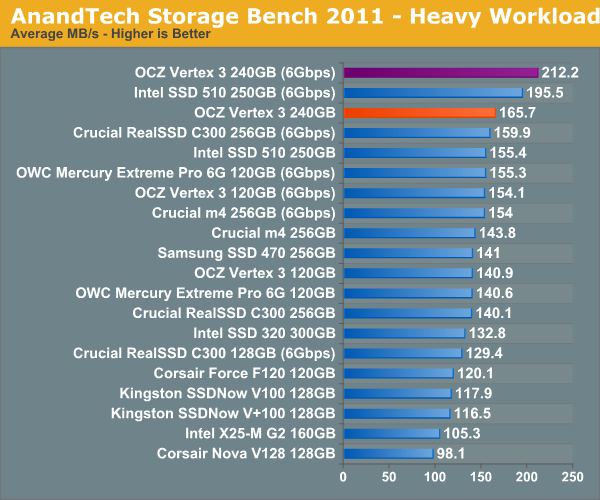
The breakdown of reads vs. writes tells us more of what's going on:
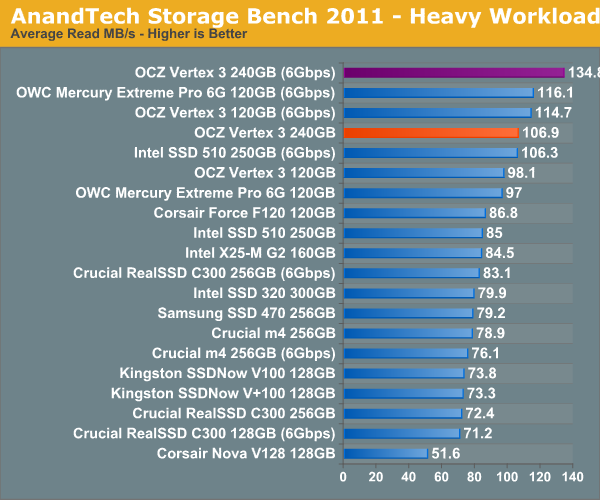
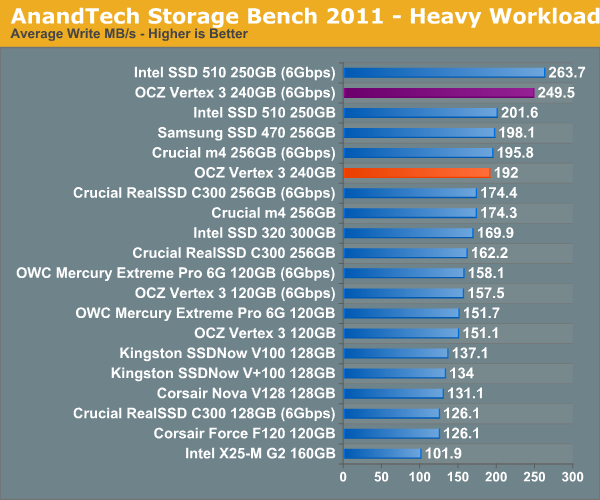
The next three charts just represent the same data, but in a different manner. Instead of looking at average data rate, we're looking at how long the disk was busy for during this entire test. Note that disk busy time excludes any and all idles, this is just how long the SSD was busy doing something:
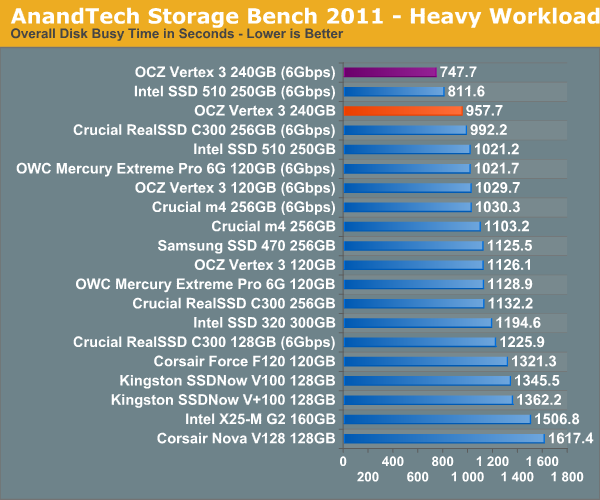
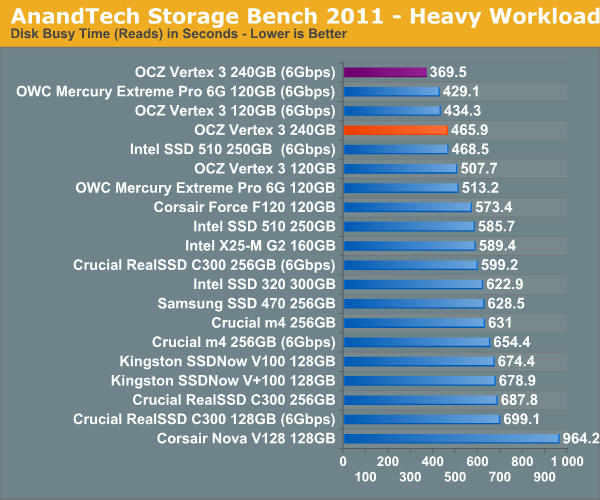
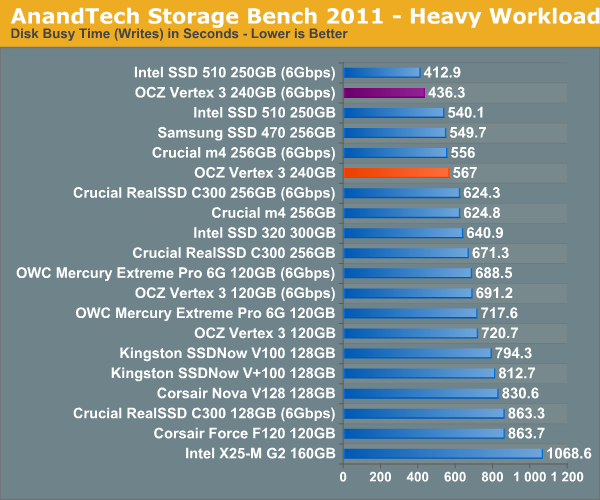










90 Comments
View All Comments
B0GiE - Friday, May 6, 2011 - link
NIce to see the review, shame you never looked at the Vertex 3 Max IOPS versions though. Any chance you can get hold of them and report on the differences?Anand Lal Shimpi - Friday, May 6, 2011 - link
Still waiting on my review sample, I'm guessing it'll be next week :)Take care,
Anand
sequoia464 - Monday, May 9, 2011 - link
Any Idea when the Samsung 470 review will be up?? Quite interested in your take on this drive.cearny - Friday, May 6, 2011 - link
Realyy great review, but in my case it raises even more doubt. I was about to pull the trigger on the 120GB version of the Intel 510, but now I don't know what performance to expect at all.Do you think you'll also be able review the lower-capacity Intel 510/320 drives in the near future?
Anand Lal Shimpi - Friday, May 6, 2011 - link
The 120GB 510 is next on my list :)Take care,
Anand
cearny - Saturday, May 7, 2011 - link
That's great news! Looking forward to the review :DM@rc - Friday, May 6, 2011 - link
I have a question regarding TRIM: if I install both Windows 7 (TRIM support) and OS X (no TRIM) on the same SSD, will that potentially cause problems?HilbertSpace - Friday, May 6, 2011 - link
Good question, I'm guessing it would only run TRIM on the windows partition and not the Mac one.ajp_anton - Friday, May 6, 2011 - link
I don't need more than 120GB. Any chance of a review of Intel's 120GB version?jjj - Friday, May 6, 2011 - link
Any word on a new firmware rls date? see http://www.xtremesystems.org/forums/showpost.php?p...Anyway waiting eagerly for M4 and Max IOPS @ 120GB reviews since those 2 seem to be the most interesting given the price/perf ratio.